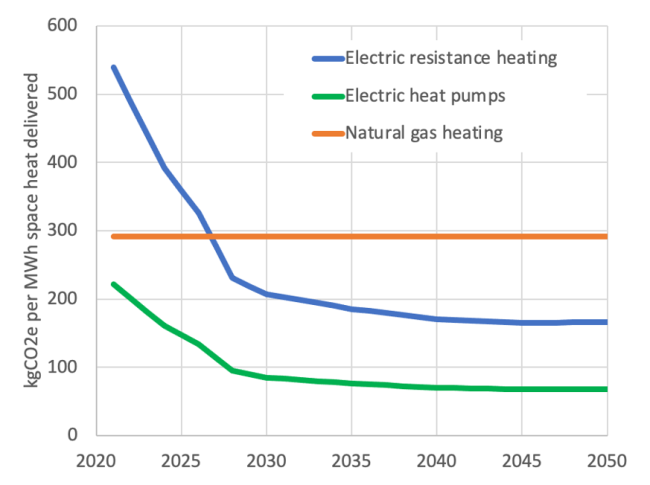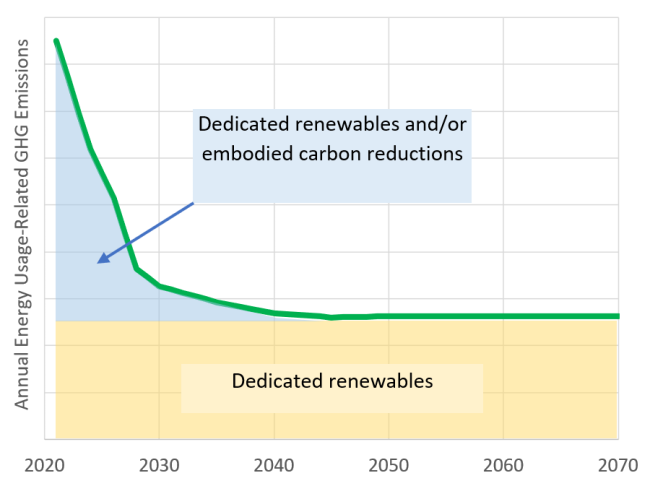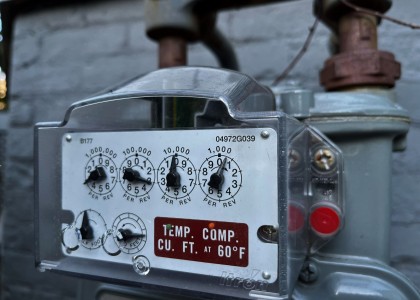Updating building energy codes is a key policy tool for energy efficiency, but achieving ambitious climate goals will require codes to focus on greenhouse gas emissions, not energy usage alone. With $670 million in upcoming federal funding for implementing zero-energy codes, financial support will soon be available to states and localities.
States and jurisdictions do not typically develop their own codes, but rather adopt model codes—so rethinking the model energy codes is necessary to help states and jurisdictions across the country cut emissions from buildings. In this post, we’ll look at some of the technical aspects of these codes to orient them toward emissions reductions that will get us on a path to net zero carbon buildings.
The benchmark model energy code for commercial and multifamily buildings over three stories is developed by the American Society of Heating, Refrigerating and Air-Conditioning Engineers (ASHRAE) and is called ASHRAE Standard 90.1. For residential buildings below three stories, the benchmark model energy code is the International Energy Conservation Code (IECC) from the International Codes Council. ASHRAE has committed to a net zero carbon 90.1 model code by its 2031 version, and the International Codes Council has an Energy and Carbon Advisory Council to inform development of the IECC. To meet their climate goals, it’s time for ASHRAE and the International Codes Council to address needed changes in the model codes and the processes by which they’re developed.
Principles to achieve net zero carbon codes
Efficiency, electrification, flexibility, renewables, and addressing non-energy-related building emissions will be essential to net zero carbon model energy codes. I’ll flesh out the role of each principle and collaborate with colleagues in the codes community at the upcoming National Energy Codes Conference, but ultimately, decarbonized model energy codes will need to be achieved through the consensus code-development processes.
Model energy codes need to work for any location across the country, so they need to be effective, adoptable, and enforceable. Four broad principles should guide our work to move toward net zero codes:
Efficiency First: Building energy codes were first developed to reduce costs for utility customers, and this remains imperative if the codes shift to focus on emissions. Further, improving building envelope efficiency reduces HVAC equipment size and can mitigate new heating-driven electricity peaks that could require new generation, storage, and delivery infrastructure capacity.
Beneficial Electrification: As the electricity grid transitions to renewables (as the figure below illustrates), current fossil fuel use in buildings will largely need to be replaced by electric heat pumps, the most cost-effective way to decarbonize space and water heating. For electrification to be beneficial, it must be efficient by primarily relying on heat pumps, not expensive-to-operate electric resistance heating. We specifically need to ensure that low- and moderate-income households and rental housing are not stuck with electric resistance heating where its low upfront costs have made it attractive to builders and landlords.
Space-heating greenhouse gas emissions over time in representative U.S. grid (ACEEE calculations based on NREL’s Cambium model and EPA Energy Star minimum efficiency residential equipment)
Flexibility: While minimum efficiency requirements need to remain, the codes should provide flexibility in how buildings achieve deeper emissions reductions. As model codes are intended to apply nationally, they need to recognize regional differences in the grid, renewable electricity growth rates, and that the lowest-emission approach may vary across buildings. For example, in some cold climates, there may be reasons to serve some peak heating needs with supplemental fuels as heat pump technology further improves and the grid gets cleaner. Emerging technologies may also play a role, such as storing heat (known as thermal energy storage or TES), batteries to optimally use on-site solar energy, grid-interactive controls to better utilize wind and solar supply through the grid, and potentially low-carbon alternative fuels. Flexibility can also provide states and jurisdictions with a framework to transition to net zero carbon codes over time. Still, support is likely needed by providing straightforward compliance options within the codes, outside technical assistance to develop location-specific roadmaps, and improved collaboration among states and jurisdictions.
Offsetting remaining emissions with renewables and embodied carbon: Until the electricity grid fully decarbonizes, even the lowest-energy all-electric buildings are not zero carbon. To date, on-site renewable energy or purchase agreements for offsite renewable electricity dedicated to the building have offset emissions associated with electricity from a grid that still relies on some amount of fossil fuel-based generation. However, as building energy usage decarbonizes, a more significant share of the greenhouse gas emissions associated with buildings will be from embodied carbon — emissions from material extraction, manufacturing, transportation, construction, usage, maintenance and repair, and end-of-life deconstruction and waste processing. Historically, ACEEE was hesitant to incorporate embodied carbon into energy codes that have set minimum efficiency requirements. We are now thinking that as energy codes shift focus to emissions, they should evolve to include embodied carbon, but first concerns need to be addressed about embodied carbon data and benchmarks. Reliable data on embodied carbon of building materials and systems are limited, making it challenging to compare embodied carbon to energy usage-related emissions (or operational carbon). With ongoing efforts to improve that data and an increasing number of states adopting Buy Clean policies for historically high-carbon materials, I propose a starting point for the energy codes: Let’s consider embodied carbon reductions as an option alongside dedicated on-site or off-site renewable energy to make up some of the interim emissions as the grid serving the building decarbonizes, as shown in the figure below. Future expansion of embodied carbon code provisions will build on lessons learned from this initial effort in the energy codes and parallel efforts in other building codes.
Dedicated renewable energy and embodied carbon to reach net-zero emissions
Additional resources needed to move to emissions-based net zero carbon codes
While the principles above guide us, significant process adjustments and supporting analyses are needed to transition from energy-focused codes to carbon-focused codes and to realize net zero carbon energy codes consistent with these principles.
Standardized carbon quantification: There are many different approaches to quantifying greenhouse gas emissions. In a promising development, ASHRAE and the International Codes Council are jointly developing a new standard method, Standard 240P, for quantifying lifecycle greenhouse gas emissions from buildings. The process started in December, and it has an ambitious schedule that will need to be met to ensure it is an effective tool to evaluate and compare emissions reduction provisions for future versions of ASHRAE 90.1 and IECC. (Disclosure: I am a voting member of the 240P committee.)
Carbon reduction credits: The most recent model energy codes include a menu of efficiency options beyond minimum requirements, among which builders must select a package of measures to achieve a required total level of efficiency performance. The model codes will need to expand or modify this scheme to focus on greenhouse gas reduction measures for different building types, climates, and grid regions. To ease compliance for relatively simple buildings, model codes should include code-compliant packages of these carbon reduction measures for common building types. There also will likely need to be guidance within the codes to ensure the expected performance level of these packages, such as for efficient all-electric or dual-fuel buildings.
Updated prototype energy models: As part of the U.S. Department of Energy’s Building Energy Codes Program, Pacific Northwest National Laboratory maintains a set of Prototype Building Models that use computer simulation to evaluate the energy savings effects of changes to 90.1 and IECC. The prototype model set is designed to compare aggregate changes in energy usage; it needs to be improved and expanded to allow for comparison of emissions impacts of potential code changes, including comparing fossil fuel-based and electricity-based systems. Prototype models are currently evaluated for representative cities for each climate zone but will need to be expanded to consider regional electricity grid emissions (e.g., the Environmental Protection Agency’s eGRID subregions or the NREL Cambium model regions).
New embodied carbon benchmark models: There are no equivalent prototype models for embodied carbon, though there are some efforts to develop them for at least some buildings, and several tools are available to assess a building’s full lifecycle emissions. Prototype models for embodied carbon are needed to evaluate embodied carbon reduction measures and code proposals for individual building types and across the building stock. To compare operational and embodied emissions, the models will need to be comprehensive, representative of current low-carbon design practices, and based on reliable and comparable data sources.
Collaboration: We will need to integrate across systems to realize whole-building emissions reductions, whether through optional provisions for jurisdictions or in the base code. In the context of code development committees, this will mean working across subcommittees that focus on building envelope, HVAC equipment, and other systems. While both IECC and ASHRAE 90.1 committees have made such commitments, we need action now to set us on a course to net zero carbon codes.
These steps will help ensure that states and jurisdictions have the model codes needed to effectively implement advanced codes that meet their climate goals and make use of current and upcoming federal funding.





